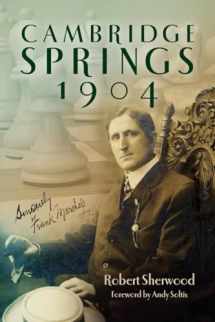
Cambridge Springs 1904
Book details
Summary
Description
About the Author
Robert Sherwood started playing chess and reading about the game in the early 1960s, playing in tournaments at the expert level. College interrupted his tournament play. He then returned to the game as a lover of chess history, assembling a library of titles on the legendary players of the past and their tournaments. When not involved with chess Bob is a contract writer, editor, and German-to-English translator working in a wide range of areas. He lives with his woman friend and animals in Dummerston, Vermont.
Marshall’s Brilliant Victory
In the spring of 1904, most of the chess world's elite gathered in the sleepy northwestern Pennsylvania town of Cambridge Springs, where the first great tournament of the twentieth century was to take place. World Champion Emanuel Lasker topped the field. The champions of America (Harry Pillsbury), Russia (Mikhail Chigorin), France (David Janowski) and the Austria-Hungarian Empire (Carl Schlechter) were also playing.
Among the other players in this historic fifteen-round-robin event was a young master from Brooklyn, Frank Marshall. He had some international experience, including defeating World Champion Lasker in their individual encounter at Paris in 1900. However, he certainly was not considered among the favorites at the time. Nevertheless, Marshall finished in first place, two full points ahead of the rest of the field, the only undefeated player.
The story of this great tournament is superbly told by author Robert Sherwood. Each game is deeply annotated, while contemporary sources and rare archival photos nicely supplement the round-by-round account.
With this victory, Frank Marshall took his place among the world-class players of his era. You are invited to join Marshall on his journey in this splendid account of his magnificent triumph in the first major international tournament of the twentieth century.
Excerpt. © Reprinted by permission. All rights reserved.
(60) Marshall – Teichmann
Queen’s Gambit Declined [D52]
Marshall tried a speculative kingside attack, sacrificing important queenside material in the process. Teichmann could have consolidated his decisive advantage but instead dangerously exposed his king with an unwise recapture, letting Marshall back into the game. The American eventually prevailed in an imperfectly played but fascinating ending that one can analyze for days.
1.d4 d5 2.c4 e6 3.Nc3 Nf6 4.Bg5 Nbd7 5.Nf3 c6 6.e3 Qa5
[Diagram]
The first Cambridge Springs Defense of the tournament. The previous year, at Monte Carlo, against the same opponent, Teichmann chose 6...Bd6. Then 7.Bd3 Qe7 8.cxd5 (a Marshall standard, stabilizing the central pawn structure and freeing up his pieces for attack) 8...exd5 9.Qc2 Qd8?! (9...0-0!?) 10.e4?! (10.0-0!?), with a typical Marshall middlegame.
7.Nd2
Later, in the New York 1924 tournament book, Alekhine would pronounce 7.cxd5 the only serious test of the variation.
7...Ne4
Swiderski-von Bardeleben, 14th DSB Congress 1904, saw 7...dxc4 8.Bxf6 Nxf6 9.Nxc4 Qc7 10.Bd3 Be7 11.0-0 0-0 12.Rc1 Bd7, with the usual White advantage.
8.cxd5
“A very pretty surprise move, which is bad however, as it rounds off Black’s pawn position and should lead to a complete loss of the opening advantage.” (Tarrasch)
“More usual is the capture with the d2-knight – a more logical move, since the latter piece has less scope.” (Reinfeld)
[Diagram]
8...Nxd2
“A surprise is generally answered with a blunder, as in this case.
After 8...Nxg5 9.h4 (not 9.dxc6 Nf6 10.h4 Nge4 saving the piece) 9...Ne4! 10.Ndxe4 exd5 11.Nd2 Nf6 followed by Bd6, Black has the better game because of his fine development and his two bishops. After the text, White obtains a good development and the advantage returns to him.” (Tarrasch)
After 8...Nxg5, interesting is 9.dxc6! (Tarrasch’s 9.h4 Ne4 10.Ndxe4 exd5 is no more than level after 11.Ng3 Nf6) 9...Nf6 (9...bxc6?! 10.h4y) 10.Bb5! (10.h4? Nge4) 10...Ke7 (10...Kd8 11.Bd3! h6 12.Nc4 Qc7 13.f4 Ngh7 14.


We would LOVE it if you could help us and other readers by reviewing the book
Book review



